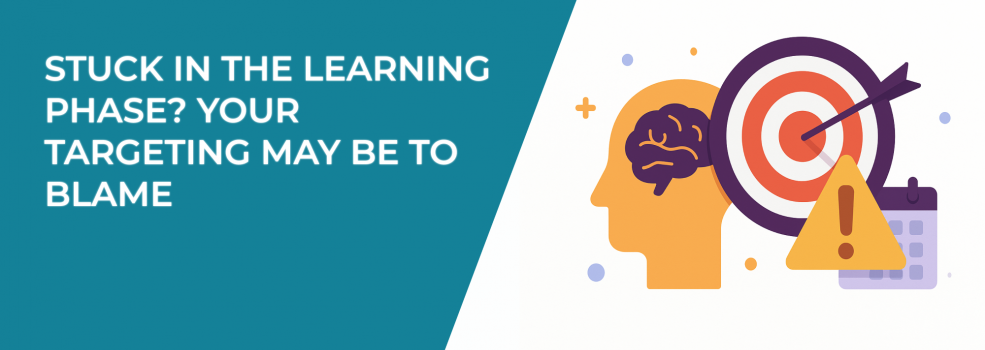When you launch a Facebook campaign, the learning phase feels like a waiting game. Ads are testing, algorithms are adjusting, and you’re hoping performance will stabilize. But what happens when the learning phase drags on, draining budget without delivering consistent results? Often, the culprit is targeting.
Targeting isn’t just a box to check in campaign setup. It dictates how fast your ads exit the learning phase and how cost-efficient they become afterward. If you’ve ever felt like your campaigns were “stuck,” chances are the issue lies not in your budget or creative, but in how you define your audience.
Why Targeting Shapes the Learning Phase
Facebook’s learning phase is designed to gather enough data for the algorithm to predict who will respond to your ads. But here’s the catch: the algorithm can only learn from the signals you provide. If your audience is too broad, too narrow, or simply misaligned with your offer, the algorithm is flying blind.
Think of it like trying to teach someone a new language using random words from different dialects. The outcome? Confusion, delays, and wasted energy. The same happens with ads: poor targeting creates weak signals that take much longer to stabilize.
Have you ever wondered why your ads burn through budget without moving out of the learning phase? The answer is usually that the system is still guessing — because your targeting hasn’t given it a clear direction. For a deeper look at how Meta’s systems process audience signals, see our guide on Facebook Ads Targeting Updates: How To Adapt in 2025.
Common Targeting Mistakes That Prolong the Learning Phase
Marketers often expect the algorithm to fix their mistakes. But Facebook’s machine learning is only as good as the data you provide. If that data is inconsistent, the learning phase stretches far longer than it should.
Some of the most common targeting mistakes include:
-
Going too broad — Large audiences force the system to test across countless user segments. The algorithm spends budget on exploration instead of refinement.
-
Layering interests without logic — Adding multiple unrelated interests may seem like precision, but it often creates a tiny overlap that’s too restrictive.
-
Ignoring intent signals — Treating everyone who clicked an ad as equally valuable is misleading. A person who scrolled back within two seconds isn’t the same as someone who watched your video to the end.
-
Overreliance on lookalikes — Lookalikes only work when the source audience is high quality. If your seed data is weak, you’re scaling noise rather than value.
Each of these errors delays optimization. Worse, they raise your cost per result because the system wastes impressions on people who were never likely to convert in the first place. If you want to dive deeper into avoiding these pitfalls, check out Why Facebook Ads Fail: 7 Targeting Issues You Didn’t Know About.
How to Refine Targeting for Faster Optimization
The solution isn’t always to spend more or launch new creatives. Often, the fastest way out of the learning phase is to improve your targeting inputs. Consider these steps:
-
Define your core audience clearly. Instead of chasing a vague “interested” crowd, get specific. For instance, a company selling subscription-based workout programs should avoid lumping everyone interested in “fitness.” Narrow it to people engaging with “home workout equipment” or “on-demand training.” That specificity gives the algorithm a head start.
-
Use exclusions wisely. Excluding past converters prevents wasted impressions. But exclusions go beyond buyers. Think about removing people who bounce quickly or interact superficially. Pruning low-value users sharpens your signals. You can learn more in our breakdown: When to Use Exclude Targeting on Facebook and Why It Matters.
-
Test in layers, not chaos. Instead of stacking 10 interests into one set, break them out. Run smaller tests, compare outcomes, and double down on proven signals. A clean testing process helps campaigns graduate from learning faster.
-
Feed the algorithm better data. Accurate conversion tracking is critical. If you’re optimizing for purchases but only tracking add-to-carts, you’re teaching the system the wrong lesson. The more precise your data, the faster the algorithm stabilizes.
These refinements don’t just shorten the learning phase—they also set your campaigns up for stronger performance long after. For structured testing tactics, see Key Strategies for Facebook Ad Testing: What You Need to Know.
When Smaller Audiences Outperform Larger Ones
A common misconception is that bigger equals better. Many advertisers assume the system needs huge audiences to learn quickly. In reality, quality beats volume.
Imagine a campaign targeting 10 million people with scattered interests. The algorithm must test across countless combinations, burning budget before it finds meaningful patterns. Compare that to a well-defined audience of one million, all closely tied to your product. The smaller pool gives the system clearer signals, letting it optimize with fewer wasted impressions.
That doesn’t mean small always wins — but precision often accelerates stabilization. Striking the balance between reach and intent is where the real skill lies. To get this balance right, explore our article on Broad or Precise? A Smart Framework for Better Facebook Ad Targeting Decisions.
Advanced Tips for Smarter Targeting
If you’re ready to go beyond the basics, consider a few advanced tactics. These approaches demand more preparation but pay off with faster optimization:
-
Segment by behavior, not just demographics. People who watched 50% of a video ad are more valuable than those who merely clicked. Build audiences around meaningful actions.
-
Use value-based lookalikes. Instead of creating a lookalike from all buyers, seed it with your highest-value customers. This helps the algorithm prioritize quality over volume. See How to Implement Facebook’s Value-Based Lookalike Audiences for Maximum Impact.
-
Rotate exclusions dynamically. Regularly update your exclusion lists — removing converters, inactive users, or unqualified leads keeps your audience fresh.
-
Align targeting with funnel stages. Cold audiences need broader awareness messaging. Retargeting pools deserve narrow, conversion-focused targeting. Mixing the two slows down learning and muddies optimization.
Each of these methods adds another layer of control, ensuring that the data Facebook collects is both relevant and actionable.
Keep Learning in Perspective
The learning phase isn’t a trap. It’s a data-gathering process. But if your ads linger there for too long, don’t assume it’s just “the system.” Take a hard look at your targeting.
Ask yourself: are you feeding the algorithm strong, clean signals? Are your audiences aligned with your offer and business goals? Or are you unintentionally sending mixed messages by chasing volume over quality?
Targeting rarely gets the spotlight in campaign discussions. Creative often steals attention, while budget tweaks dominate optimization chatter. Yet targeting quietly dictates whether your campaigns stabilize smoothly or stall indefinitely.
The next time your ads feel stuck, resist the temptation to simply adjust bids or swap images. Examine your audience setup first. You may find the fastest way out of the learning phase isn’t more spending — it’s smarter targeting. If you need a practical roadmap, don’t miss How to Optimize Facebook Campaigns for Faster Learning Phase Exit.

